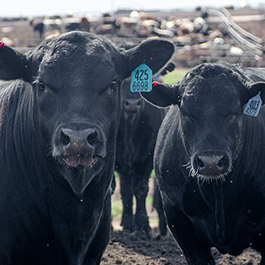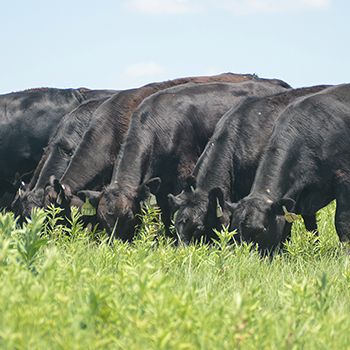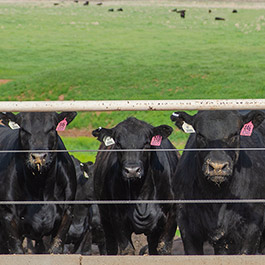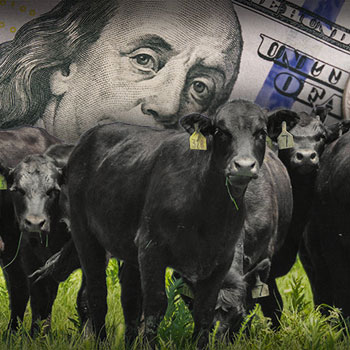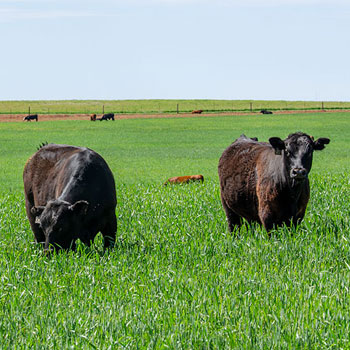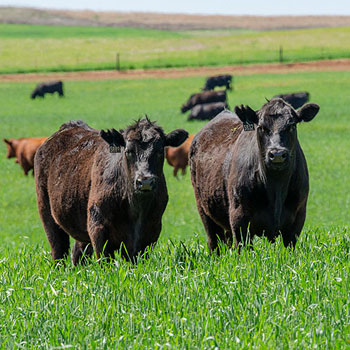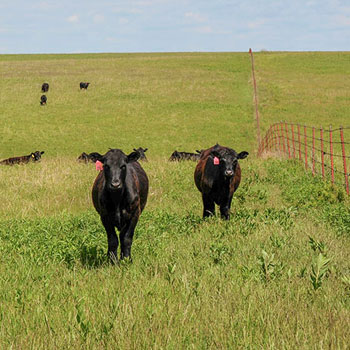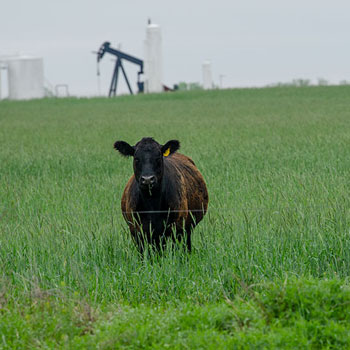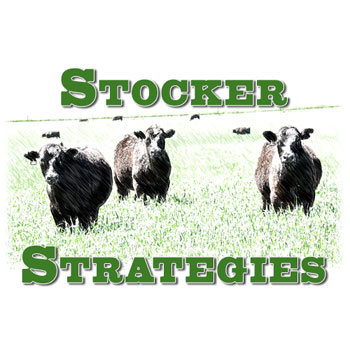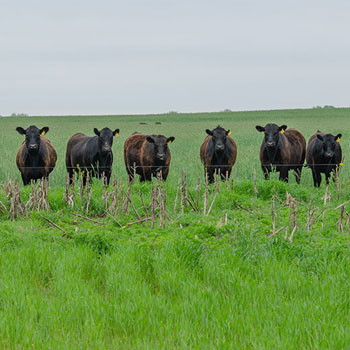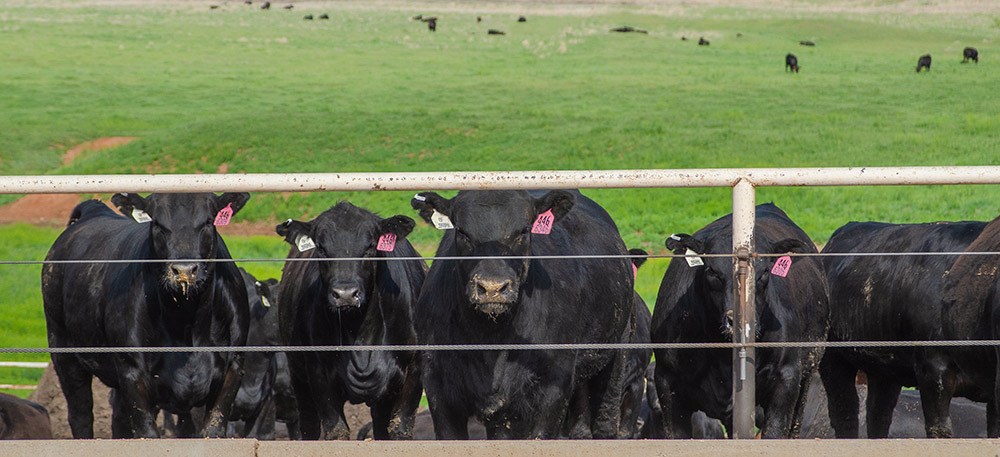
Nutrition Reception
In Part 2 of this series, our authors focus on the nutritional aspects of receiving stocker cattle.
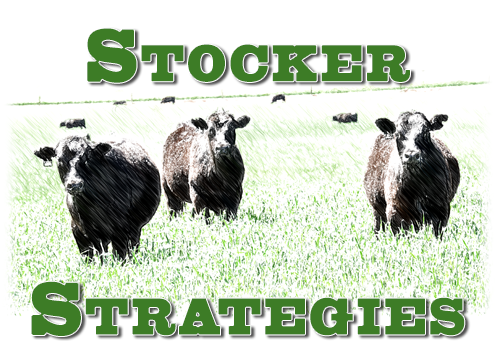
Successful stocker operations have a plan that requires preparation before the cattle arrive. The receiving plan should include:
- well-designed facilities for ease of handling newly received cattle,
- a nutritional program to address the special needs of stressed cattle,
- a program designed to manage and care for sick or injured cattle, and
- personnel properly trained in identifying and handling sick cattle.
A well-designed nutritional program is a vital part of a successful stockering enterprise. In this article, our authors take a look at the nutritional strategies for managing newly received calves.
The receiving phase is a unique and challenging period in a calf’s life. Proper nutritional management at receiving is fundamental to improving the profitability of stocker programs.
Receiving diets Newly received calves typically have decreased feed and water intake for a day to several days. Upon arrival, calves should be placed in small lots with adequate shade and clean water. Calves weighing more than 400 pounds (lb.) will likely be able to easily recognize and consume hay. They should have access to good-quality grass hay to stimulate proper rumen function.
Let the calves shipped from long distances rest upon arrival, and plan to process them the next morning.
Calves must be able to quickly recognize and consume feed. On average, feed intake of newly received calves is low. Because of this, diets for newly arrived stocker calves should be formulated to maximize intake and provide greater concentrations of required nutrients.
Receiving diets must be highly palatable, stimulate intake, provide acceptable levels of critical nutrients and minimize the potential for nutritional disorders. Generally, receiving diets that contain more than 55% concentrate can lead to digestive problems, resulting in higher medication costs.
It is important to know which feedstuffs are helpful in receiving diets. Although cottonseed hulls are relatively low in nutrient value compared to other feedstuffs, they can serve as a good fiber source, or “scratch” factor, to stimulate gut movement and reduce the risk of acidosis. Cottonseed hulls are generally very palatable to cattle and can work as an appetite stimulant.
Pelleting ingredients such as soybean meal, minerals and other additives can promote intake as long as the pellets are not too hard or too large [diameter of pellet should be ½ inch (in.) or less]. Pelleting roughages reduces the “scratch” factor, so any pelleted diet needs to include at least 2 lb.-3 lb. of long-stemmed hay per day.
Diet formulation should take the age and size of the calf into consideration. As a general rule of thumb, receiving diets should be formulated so the calf receives maintenance requirements for protein, vitamins and minerals when feed consumption is 1.0%-1.5% of body weight. Lightweight (350 lb. or less) and early-weaned (at or before 4 months of age) calves may need more nutrient-dense diets than larger, later-weaned calves. These lighter calves require a higher percentage of protein and a better source of digestible energy in their diets than do larger calves.
For lightweight calves, a diet with free-choice hay as the main ingredient is not as effective as a complete, mixed diet that contains higher levels of concentrates. A complete, mixed diet for lightweight calves has the added advantage of reducing the possibility of the calves sorting roughage from grain. If ground hay is used in a mixed diet, it should not be ground too finely. Leave 1½-in. to 2-in. stem lengths and, if needed, add molasses to control dust.
The source of protein is critical in receiving diets. Nonprotein nitrogen (urea) is not recommended in receiving diets for calves weighing less than 600 lb. It should be avoided altogether for feeding lightweight calves. Plant-protein sources such as soybean meal, cottonseed meal and alfalfa are acceptable protein supplements for these calves. For young calves, soybean meal is preferable to cottonseed meal because of the potential for problems with gossypol from cottonseed meal, particularly in calves weighing less than 400 lb.
Proper salt and mineral supplementation is an essential component of a good nutritional program for stocker calves. Phosphorus (P) levels are typically low on forage-based diets, so next to sodium (Na) and chloride (Cl-), phosphorus is a key mineral to supplement to balance the diet. Trace minerals such as zinc (Zn) and copper (Cu), along with vitamins A and E, are also important in meeting the nutritional needs of stocker calves.
Nutritional considerations for stressed calves Stressed calves have special nutritional concerns. Stress places demands on the bodies of calves that can result in performance losses. Common stresses on young cattle include weaning; handling and hauling; feed and water deprivation during the marketing process; exposure to temperature or weather extremes; and processing practices, such as dehorning, castration and vaccination. Crowding and disease exposure are additional stressors often associated with commingling feeder calves. Drought is another stressor for growing cattle.
Nutrition and stress are closely associated. Nutritional deficiencies in protein or energy can stress calves. Likewise, environmental stressors can produce or intensify nutritional deficiencies. Stocker operators should consider practices to minimize stresses, as well as methods of coping with the effects of stress on calves. This publication highlights many of the recommendations the National Research Council (NRC) reports for stressed calf nutritional programs.
Rumen fermentation involves microorganisms such as rumen bacteria, protozoa and fungi. This process is a critical part of the digestion and use of feedstuffs in stocker calves. Newly arrived calves to a stocker operation likely have undergone periods without feed and water during the course of marketing and shipping. Rumen fermentation processes and capacity are decreased by feed and water deprivation and remain depressed for a few days after calves regain access to feed and water. Rumen microorganism levels drop sharply after calves are stressed. When transportation stress is added to the stress from feed deprivation, longer recovery periods are needed for levels of rumen microorganisms to return to normal. These ruminal changes result in decreased calf appetite and feed intake.
One of the most challenging management problems resulting from stress on calves is lowered feed intake. Feed intake decreases by more than 50% in calves experiencing respiratory disease and fever. It is often difficult to meet nutrient requirements in calves suffering from bovine respiratory disease complex (BRD) because of the dramatic reductions in feed consumption. It sometimes takes up to two weeks for calves to resume normal feed intake after the start of respiratory disease. Low feed intake is of particular concern when using medicated feed additives requiring adequate intake for effectiveness against conditions such as coccidiosis.
While protein and mineral requirements of stressed calves may not differ from unstressed calves, protein and mineral supplementation levels may need to be increased with stressed calves to compensate for reduced feed intake. Increasing diet nutrient density helps supply adequate nutrient levels when feed intake is depressed. Receiving diets for lightweight, stressed calves should target 13.5%-14.5% crude protein (CP) on a dry-matter (DM) basis to meet protein requirements. In cases of severe intake depression, dietary DM protein levels may need to approach as high as 24% CP.
Much of the shrink or weight loss common with calf marketing, shipping and processing is water loss. Longer transits increase weight loss and calf stress. Body water loss (as opposed to rumen water loss) can increase mineral loss and, combined with low feed intakes, lead to mineral deficiencies. In cases where shrink is more than 7%, nutritional programs for stressed calves should include 1.2%-1.4% potassium (K) in the diet for two weeks after arrival.
Additionally, high concentrations of zinc have been shown to benefit calves suffering from illness. Suggested zinc concentrations for stressed calves are 75 ppm-100 ppm of dietary dry matter.
Vitamin E and selenium are also involved in immune function. During the receiving period, vitamin E should be fed at levels between 400 IU and 500 IU per head per day. Later, at least 100 IU of vitamin E with 0.1 ppm selenium (Se) per head per day should be provided.
Supplementation of B vitamins, such as niacin, has also been shown to improve performance of stressed calves. Daily niacin supplementation of 125 ppm for healthy calves and 250 ppm for sick calves can be beneficial.
Health problems can occur in calves when diet energy content is either too high or too low. Low-energy diets may reduce immune function. High-energy diets can also contribute to health problems, but hay supplementation of high-energy diets for three to seven days can alleviate these problems. Hay offered to calves should be good-quality grass hay.
Stressed calves have a very low tolerance for fat in the diet. Fat content for receiving diets should not go over 4% of the dietary dry matter. Commonly used feedstuffs containing relatively high fat levels include whole cottonseed, dried distillers’ grains and rice bran (unless it has been defatted). Reduced feed intake and scours can be expected with excessive fat supplementation.
Some feedstuffs are better for stressed calves than others. Stressed calves do not respond to nonprotein nitrogen (urea) in the diet as well as unstressed calves. Some suggestions are that increasing rumen bypass protein supplies can increase performance of stressed calves, but research results are mixed. Soybean meal is generally considered a much better source of rumen bypass protein than cottonseed meal. Avoid heat-damaged feeds for stressed calves, because they may have reduced levels of protein available for the animals to use. Another feed-related factor to consider when receiving stocker calves is that newly arrived calves often prefer dry feeds over wet feeds, such as silages. However, calves will adapt to high levels of high-moisture feeds such as corn silage in one to two weeks.
Feeding management Good management can help newly arrived calves get on feed as quickly as possible. Calves initially walk the boundaries of their new pens searching for a way to escape. Placing feedbunks and water troughs along the fencelines of receiving pens, as opposed to in the center of the pens, increases the frequency of calves’ walking past the bunks and troughs. Therefore, calves find water and hay more easily if they are placed along the fences. Using trainer or lead cattle to show newly arrived calves the locations of feed and water can also be effective.
Adequate bunk or trough space is another important consideration in receiving pens. Timid calves may not receive sufficient shares of feed if bunk space is limited. At least 12 linear in. of bunk space per head is recommended for incoming cattle. A good guideline is to provide 18 in.-24 in. of bunk space per calf. This limits crowding at the bunk, and allows timid cattle more of an opportunity to feed.
Feed cattle approximately the same time each day to establish a routine, consistent eating time. Twice-a-day feedings can be worthwhile the first two to three weeks of the receiving period for highly stressed, young or lightweight cattle. Sick calves may be slow to come to the feedbunk, so it is useful to observe feeding behavior to help identify potential health problems.
Clean feed and water troughs before calf arrival and then closely monitor troughs. Remove any moldy feed, fines, chunks of caked or damaged feed, manure, or trash from feed supplies offered to calves. Finally, implement diet changes gradually after receiving.
Receiving nutrition is one component of a good plan for managing stocker cattle. Additional components include:
- well-designed facilities for ease of handling newly received cattle,
- a program designed to manage and care for sick or injured cattle, and
- personnel properly trained in identifying and handling sick cattle.
See “Welcome Reception” on the Management page for information on facility design for receiving stocker cattle. Watch future editions of the ABB EXTRA for additional articles in this series.
Editor’s note: This article is excerpted and reprinted with permission from Mississippi State University Extension publication number P2506: Stocker Cattle Receiving Management, which can be viewed in its entirety at https://extension.msstate.edu/sites/default/files/publications/p2506.pdf. Jane Parish is professor and head at the North Mississippi Research and Extension Center; Justin Rhinehart is a former assistant extension professor of animal and dairy sciences at Mississippi State University, now associate professor at the University of Tennessee; and Richard Hopper is a professor of pathobiology and population medicine at Mississippi State. Photo by Kasey Brown
